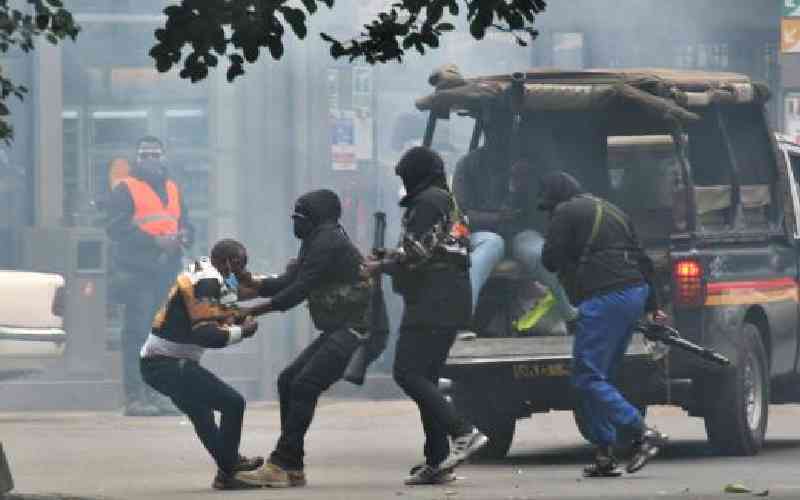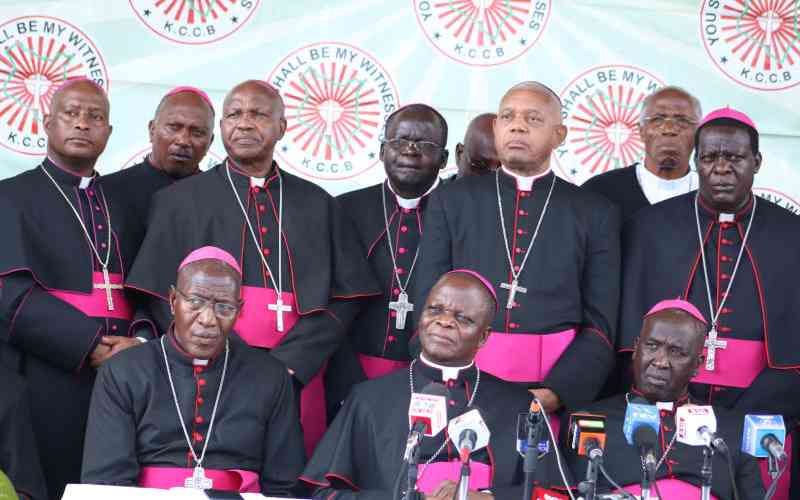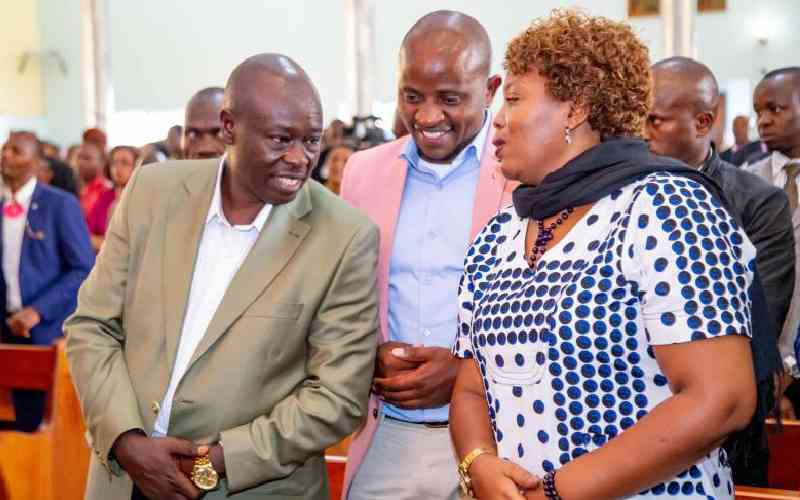Meru, Kenya: Protestors blocked Meru Governor Peter Munya’s way, preventing him from leaving a hotel as the border dispute between Meru and Isiolo counties continued to simmer.
A group of Isiolo residents blocked the Meru governor and his entourage from leaving the hotel in Shaba Game Reserve where they had been holding a workshop with senior officials from the Commission on Revenue Allocation and Transition Authority last weekend. They left only after calling for police reinforcement, and through an alternative route to avoid the protestors.
Meru and Isiolo counties have been engaged in a row over the collection of cess along their borders.
The group was protesting Munya’s removal of cess collection points set up by the Isiolo County Government in one of the disputed areas. The governor said the roadblock was in Meru.
In retaliation, Isiolo Governor Godana Doyo led other leaders and residents in dismantling revenue bases set up by the Meru County Government.
Although the two counties have mostly been feuding about sand harvesting charges and cess collection, some local leaders believe the real dispute is about land ownership in an area that does not clearly fall in Meru or Isiolo.
“We want to be good neighbours with Isiolo. The two communities have been living together for a long time and want to know where the border is. As a county government, we have big projects we want to undertake, but are being delayed by the boundary matter,” says Munya.
His Isiolo counterpart claims that each county knows the border and mutual respect is all that is required.
“We had hoped that this matter would be resolved amicably. We are surprised it has taken this long to resolve,” says Doyo.
The disputed border area includes parts of Chumvi Yarre, Gambella, Tractor and Kisima, all of which are close to Isiolo Town. It is said that the Meru claims put not only the Isiolo International Airport but indeed the whole of Isiolo Town in Meru.
Tension has been heightened by the impending start of the Lamu Port, Southern Sudan and Ethiopia Transport (Lapsset) project as well as the proposed Isiolo resort city. Land owners are hoping to cash in on compensation for land to build roads, railways and an oil pipeline, and expansion of Isiolo Town.
Meru elders claim Isiolo communities took over the Isiolo rangelands for their livestock and now stand to reap from the proposed resort city.
Igembe North MP Joseph ‘Eruaki says a large swathe of his constituency, including Kinandutha, Ndumuru and Ilat sand harvesting areas, are being claimed by Isiolo. The areas are also believed to have iron ore deposits.
Land Development and Governance Institute (LDGI) executive director Mwenda Makathimo says the current conflict makes no sense.
Signed accord
Stay informed. Subscribe to our newsletter
A former commissioner in the defunct Interim Independent Boundaries Review Commission, Makathimo insists there is no boundary dispute between Meru and Isiolo counties.
“What we are seeing is a fracas not based on the empirical matter of boundaries. When we sat as a commission, there was no complaint over the boundary. What is happening is a lack of respect for established boundaries,” says the former chairman of Institution of Surveyors of Kenya.
Makathimo says the boundaries of a county can be altered only by a resolution recommended by an independent commission set up for that purpose by Parliament and passed by at least two-thirds of all MPs. The Senate also has powers to pass such a resolution that must be passed by at least two-thirds of all of the county delegations.
Last December, elders from various parts of the country moved in to arbitrate the protracted boundary dispute during a meeting convened by the Ministry of Interior and Coordination of National Government. The forum was attended by representatives from government agencies, including the Independent Electoral and Boundaries Commission (IEBC) and the National Land Commission (NLC).
During the meeting, Isiolo and Meru elders signed an accord committing to promote peace and harmony among their communities, and resolved to respect the outcome of the boundary identification. It was resolved that the IEBC and NLC and other relevant government agencies would identify the boundary between the two counties.
“Elders will sustain dialogue between the communities and involve their respective governors and county commissioners for amicable use of common resources,” the resolution read by Hassan ole Kamwaro, former Transport and Licensing Board chairman, said.
Long-serving MP and assistant minister Mathew Adams Karauri from Meru County says the issue of unclear boundaries should not arise.
“It is really a matter of lack of political goodwill because there are clear boundaries surveyed and demarcated during the colonial times,” he says. “We only need the relevant agencies to identify them.”
Karauri says the biggest fear is that people will lose their land in the disputed area once the county boundaries are identified. But he says this should not be an issue because landowners must be assured of their rights, no matter which county the borders place them in.
Dr Thiakunu Mwirabua, a Njuri Ncheke elder, and who has been involved in the arbitration of the border dispute, says the problem started in 1998 when the then Isiolo County Council stopped paying lease fees to the Meru County Council, as had been the norm since independence.
Mwirabua traces the origin of the squabble to the colonial district commissioner’s decision to move from Garbatullah to the present location of Isiolo Town. Isiolo allegedly leased a five-kilometre strip along the Ewaso Nyiro from the Meru administration.
Mohamed Guleid, the deputy governor of Isiolo, agrees that most of the tension is a result of the informal land tenure system in the area and fear of the unknown.
“We want to assure the Meru population in Isiolo and all other Kenyans that nobody has any grounds to interfere with their land ownership, wherever the IEBC places the contested areas,” says Guleid.
However, he says the lease fee allegedly paid by Isiolo to Meru until 1998 has no relevance in the current dispute. “Historical factors of 30 years ago don’t matter in today’s arbitration. Our position as Isiolo county is that somebody has to come to the ground, measure distances and place beacons.”
He blames the Interior Ministry and Isiolo South MP Abdullahi Banticha also accuses the Ministry of Interior of failing to act.
“It is a sensitive matter, and both county governments need to exercise restraint,” says Banticha.
However, NLC’s Commissioner Clement Isaiah Lenachuru says inter-boundary conflicts are more political than technical, and there are elders who are able to correctly interpret the boundaries.
“The matter has to be resolved by the two governments, the IEBC and the Ministry of Lands, who are the custodians of all land maps,” says Lenachuru.
IEBC Director of Communications Tabitha Mutemi said only the commission’s boundaries officer could speak about the progress on the issue. He was not immediately available for comment.
 The Standard Group Plc is a
multi-media organization with investments in media platforms spanning newspaper
print operations, television, radio broadcasting, digital and online services. The
Standard Group is recognized as a leading multi-media house in Kenya with a key
influence in matters of national and international interest.
The Standard Group Plc is a
multi-media organization with investments in media platforms spanning newspaper
print operations, television, radio broadcasting, digital and online services. The
Standard Group is recognized as a leading multi-media house in Kenya with a key
influence in matters of national and international interest.
 The Standard Group Plc is a
multi-media organization with investments in media platforms spanning newspaper
print operations, television, radio broadcasting, digital and online services. The
Standard Group is recognized as a leading multi-media house in Kenya with a key
influence in matters of national and international interest.
The Standard Group Plc is a
multi-media organization with investments in media platforms spanning newspaper
print operations, television, radio broadcasting, digital and online services. The
Standard Group is recognized as a leading multi-media house in Kenya with a key
influence in matters of national and international interest.






